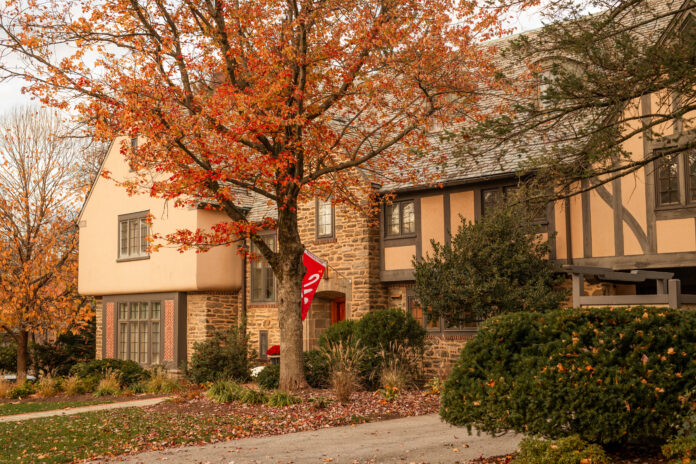The Sept. 7, 2023 issue of The Muhlenberg Weekly reported in its “Campus Safety Notes” that there was a “Report of bat in President House, bat found and taken outside.” This was not, however, the first time that an incident like this was reported, as Muhlenberg has a lengthy history of bat sightings and subsequent relocations. In fact, the Pennsylvania Game Commission (PGC) states that there are “Nine species of bats [that] regularly occur in Pennsylvania; six hibernate in Pennsylvania and three primarily migrate south for the winter.” The PGC adds that there are two species that infrequently migrate north to Pennsylvania from the south.
Associate Director of Campus Safety Brenda Lakis states that “it’s always been an issue [at Muhlenberg], especially in our older buildings.” She continued noting that, in their experience, bats tend to gravitate toward these buildings for warmth. “Whenever you have the type of four seasons like we do, it’s starting to get cold out, they’re going to look for areas to hunker down where it’s warm.” Lakis pointed out that buildings such as Brown Hall and East Hall, prior to its renovation, were common spots for bats to seek shelter. She even notes that at one point, there was such a large number of bats in Egner Memorial Chapel, that they had to “have a professional company come in and go into the attic,” as “you would literally sit in the pews and bats would be swooping into you.”
Ashley Henry ‘26 recalls the moment she and her roommate dealt with a bat: “My roommate and I had three bat experiences while living in Brown Hall last year; however, our first encounter was probably the most memorable. It was our second day of pre-orientation, and we heard screaming from the hallway. We decided to open up our door to see what was happening, and that’s when we noticed the bat flying down our hallway. Suffice it to say it was certainly a unique welcome to the building.”
Lakis made note of the fact that, as Pennsylvania Bat Rescue concurs, “In Pennsylvania it’s illegal to harm, kill or inhumanely remove bats,” as they are headed toward extinction. PGC states that “The biggest threat to our bats during hibernation is a relatively new disease called white-nose syndrome,” an exotic fungus that can cause infections to parts of the bats’ skin, typically leading to death. They add that there’s a roughly 99 percent mortality rate for those species that hibernate in Pa. This infection has caused a significant population of bats to die off, putting some species on the federal endangered species list.
Though they’re not large in population, many bats have come to call Muhlenberg home. As President Kathleen Harring, Ph.D. commented, “We see lots of bats in our backyard, particularly during the summer and are happy to have them since they help control the bugs.” It was due to their continuous presence that on that Saturday evening, Harring quickly identified the creature in her home as a bat, recalling that she may have scared the animal upon reaction, causing it to hide in her curtains. She then called Campus Safety, since she “knew they had experience getting bats out of buildings in a humane manner.”
Lakis commented that upon hiring new Campus Safety team members, they’re taught how to handle bat-related calls. One of the easiest yet least successful strategies is simply to open a window and hope that the bat flies out. “The officers have clear protocols and typically open windows and doors to give the bat multiple ways to escape if it flies around the house,” added Harring. “The Campus Safety officers and my husband opened windows near where the bat was hiding inside the curtains. It helped that we knew exactly where it was at the time.” However, when the bat wasn’t able to leave on its own, “they used two nets to capture the bat and take it outside to be released.” Lakis also stated that they have different gear, including nets and softer grabbing mechanisms to help safely take control of the animal and help it outside. “[Campus Safety] brought a net that folded inward to trap the bat. It worked, and the bat was safely removed from the building.”
“The Campus Safety officers and my husband opened windows near where the bat was hiding inside the curtains. It helped that we knew exactly where it was at the time.”
President Kathleen E. Harring, Ph.D.
Henry noted, after commenting that on their first incident, “we decided to remove it ourselves… Our efforts succeeded, and the bat was removed; however, it is not something I plan to ever do again.” In some cases, Plant Operations may be contacted or will reach out to a third-party organization for extra assistance.
As far as residential buildings, Lakis stated that students should call Campus Safety to aid in the removal process. If the bat is in one’s dorm room or sleeping area, “Our protocol also states that they should speak with an on-call nurse in the call center.” She says, “Bats are infamous for carrying certain diseases. If they’re in a sleeping area, you’re not 100 percent sure where they’ve traveled.” She concedes, though, that the likelihood of contracting any disease is low and that the most important thing is for students to contact Campus Safety first, and then receive guidance on the next steps.
“They’re just as scared as you are.”
Associate Director of Campus Safety Brenda Lakis
Lakis commented on how docile these bats are, and that “they’re just as scared as you are.” Overall, the animals are simply looking for warmth and shelter and are not to be feared by the greater Allentown community. If anything, it’s of utmost importance that they are treated humanely so as not to aid in their population decline, allowing them to flourish and continue their role in the ecosystem.
Harry Glicklin '26 is a media & communication and English double major who is absolutely jazzed to be both a Copy Editor and a writer for The Muhlenberg Weekly. Outside of ~the office~, Harry is a member of the Muhlenberg AcaFellas, Hillel and the WMUH Allentown radio station.






















